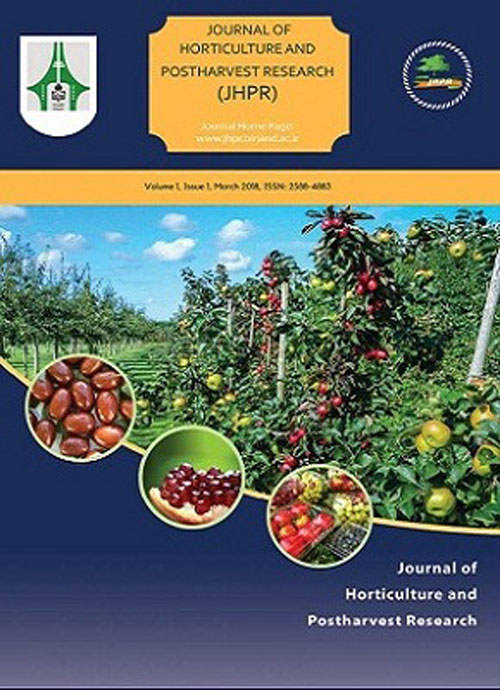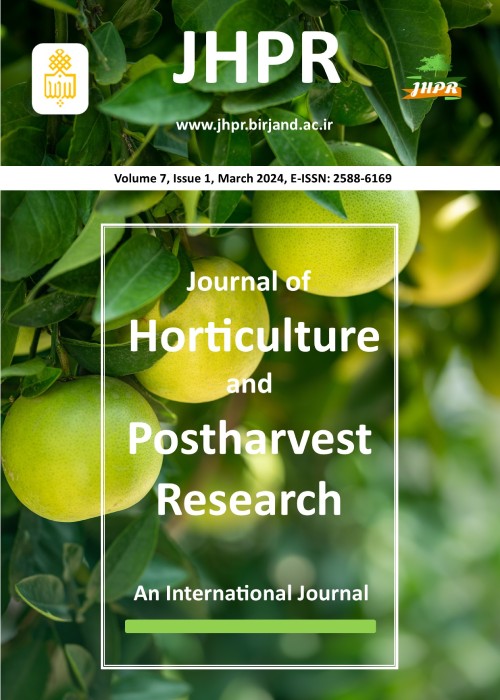فهرست مطالب

Journal of Horticulture and Postharvest Research
Volume:1 Issue: 1, Mar 2018
- تاریخ انتشار: 1396/12/10
- تعداد عناوین: 6
-
صفحات 63-72
-
Pages 1-14Jujube fruits have a short shelf life due to its perishable nature. Preservation of jujube quality is a big challenge. Edible coatings have been used for centuries in the food industry as an effective method to preserve food products, enhance shelf life and prevent loss of firmness and moisture in fresh fruits. However, little information is available on the overall quality attributes of Chinese jujube fruits influenced by edible coatings. Hence, the influence of different edible coatings including aloe vera gel (AV) (33 and 50% v/v), carboxymethyl cellulose (CMC) and pectin (1, 1.5 and 2% w/v) was studied on fresh jujube quality during 40 days of refrigerated storage at 4 °C. The results showed that weight loss was approximately reduced by 30% in coated jujubes with Aloe vera 33% v/v or 1.5% w/v pectin after 40 days compared to uncoated control. Uncoated fruits presented a higher and significant decay after 40 days of storage than other coating treatments. Results also indicated that the coatings with 50% v/v Aloe vera, 1 and 2% w/v CMC caused a higher and significant TA in jujube fruits, and preserved sensory acceptability as well as improved appearance quality of fruits compared to uncoated fruit. In general, coated fruit with Aloe vera at both concentrations and CMC at 1 and 1.5% after 40 days of refrigerated storage maintained the quality of jujube fruits better than control.Keywords: aloe vera gel, carboxymethyl cellulose, fresh fruit, pectin, Ziziphus jujuba Mill
-
Pages 15-26Todays, contamination of agricultural soils by different ways of salinity is increasing as a result of human and environmental factors that would reduce yield and quality of agricultural crops. However, there are some plants that can tolerate some degrees of salinity. Tomato is one of the horticultural crops, moderately sensitive to salinity even that salinity can improve its quality. So, a study was conducted using four varieties of tomato under normal and salt stress (3, 6 and 9 dS m-1) hydroponic conditions to evaluate tomato quality. The results showed that increasing in salinity improves the quality and taste of tomato with a reduction in pericarp thickness, fresh weight and total protein. However, when the degree of salinity exceeds 6 dS m-1, a significant difference was observed in fruit yield which was variety dependent. Also, there is a significant difference between salt tolerance, performance, and taste of different varieties. Furthermore, it is found that the activity of guaiacol peroxidase and catalase enzymes increased as well as an increase in the level of salinity. Tomato cv. Super Chief with the highest number of fruits per plant, high level of proline as well as catalase activity, has the best performance against salinity levels of soil and was more resistant to salinity than other varieties. Also, tomato ‘Super Chief’ had the highest taste index with a slightly decline in the yield. Salt stress tomatoes have more carotenoid than controls but the level of 9 dS m-1 salinity was not tolerable by all varieties.Keywords: Antioxidant enzymes, edible quality, salt stress, Yield
-
Pages 27-36The effects of thiamin (Thi) applied as foliar spray on some morphological and physiological traits were investigated in basil (Ocimum basilicum L.). Four levels of Thi including 0 (distilled water), 250, 500 and 750 µM were tested in a randomized complete design with three replications at research greenhouse of University of Guilan, Iran. Thi exerted a significant effect on the most studied indices. The highest amounts of leaf, stem and root dry weights and number of lateral branches were obtained in plant which were treated by 500 µM Thi. Thousand grain weight increased by increase in Thi levels, as, its value in 700 µM Thi, was 26% more than control. Thi spraying especially in concentration of 750 µM improved the leaf nutrients content (N, P and Ca). Chlorophyll b content in leaves affected positively by Thi, and its highest value obtained in 750 µM treatment (0.75 mg g-1 FW). The highest and the lowest phenolic compounds were gained in 0 and 750 µM levels of Thi (47.2 vs. 40.3 mg 100g-1 FW). Similar trend was observed about total antioxidants, where their content in 750 µM was 13% more than control treatment. Generally, it seems that Thi can be considered as an appropriate growth regulator in basil medicinal plant cultivation.Keywords: Chlorophyll, Growth Regulator, leaf nitrogen content, phenolic compounds, total antioxidants
-
Pages 37-48Button mushroom (Agaricus bisporus L.) is marketed for its unique flavor and benefits. The shelf life of fresh button mushroom is limited and its quality decreases rapidly during storage mainly due to high respiration rate. Postharvest changes of browning of the cap, softening of tissues, moisture loss and development of off-flavor lose its marketability. Modified atmosphere rich in CO2 can modify respiration rate, energy metabolism and physiological changes in postharvest storage of many fresh products. In this study, button mushrooms were treated with high CO2 concentration (95%) for 0 (control), 6 or 24 h. Thereafter, the mushrooms were ventilated and packed in polyethylene lid containers 500 ml (packed with its lid) (PE-LC) or polyethylene containers cellophane wrapped (PE-CCW) and were then stored in a refrigerator at 4 °C for 14 days. The results showed that high CO2 treatment for 24 h that were packed in polyethylene container cellophane wrapped significantly affected the shelf life and maintained the flavor of button mushroom during refrigerated storage compared to the control. In addition, after 14 days of cold storage 24 h high CO2 treated samples that were packed with PE-CCW had better taste and flavor than the control. Color of treated mushrooms especially the BI index in both CO2 durations was better than control samples. Generally mushroom whiteness, which is an important quality aspect, was also observed the best in 24 h high CO2 treated samples packed with PE-CCW than other treatments and the control.Keywords: color, modified atmosphere packaging, mushroom, shelf life
-
Pages 49-62Silverberry fruit is an important medicinal fruit that used for reducing pain. The present work was carried out to study the effect of potassium meta-bisulfite (KMS) and air drying temperature on quality of Russian olive fruit. Different KMS levels (0, 1, 2 and 4%) and drying temperatures (45, 60 and 75°C) were used and some traits such as weight loss (WL), rehydration ratio (RH-R), TSS (total soluble solids), TA (total acidity), TSS/TA ratio, ascorbic acid, color parameters (L*, a*, b*, chroma and Hue, TEPL, TEPa and TEPb, ΔE and BI), total phenol (TP), and potassium were measured. WL, RH-R and total color change (ΔE) increased with increment of pre-treatment concentration. All traits except TSS, were significantly affected by drying temperature. TA, ascorbic acid and TP raised by increasing air temperature from 45°C to 60°C. Temperature higher than 60°C increased ΔE. Increment of temperature from 45°C to 75°C led to an increasing trend of browning index, a*, b* and C* (chroma), however, L* (lightness) and hue angle decreased. In general, using higher KMS concentrations as pre-treatment improved weight loss during drying, however, significant color change observed and color retention significantly reduced. Drying temperature higher than 60°C also increased browning index of Russian olive fruit, however, total phenols increased in parallel. Thus, it is suggested that drying temperatures lower than 60°C may be good treatment for drying silverberry fruits.Keywords: air-drying temperature, browning index, potassium metabisulfite, weight loss
-
Pages 63-72Edible coatings are an environmentally friendly technology that is applied to many products to control moisture transfer, soluble and aromatic materials, gas exchange or oxidation processes. The objective of this research was to study the effect of tragacanth gum at the concentrations of 0, 5, 10, and 15 kg m-3 on storage life and edible quality of apple cvs. Red Delicious and Golden Delicious. After applying treatments, the fruits were kept in a cold storage at a temperature of 0±1 ˚C and relative humidity of 85-95 percent. The weight reduction, external quality, microbial load, and general acceptability of the samples were evaluated after 0, 30, 60, 90 and 120 days of storage, then compared with uncoated apples. It was found that the tragacanth gum significantly reduced fruit weight loss compared to the control, so that weight reduction in uncoated apples was eight times greater than fruits treated with tragacanth gum at 10 kg m-3. This coating preserved firmness of fruit tissue in storage and prevented the softening and senescent breakdown of apples. The tragacanth gum coating desirably preserved the external quality and improved the microbial load, sensory and external properties of the fruits, preserved quality factors of the apples, and prevented fruit ripening during storage. Among the various treatments, the coating at 10 kg m-3 was more effective than the other treatments, maintained fruit juice acidity and pH at desirable levels, and prevented increases in the contents of soluble solids during the storage.Keywords: Astragalus, Golden Delicious, Red Delicious, storage life, Tragacanth gum


